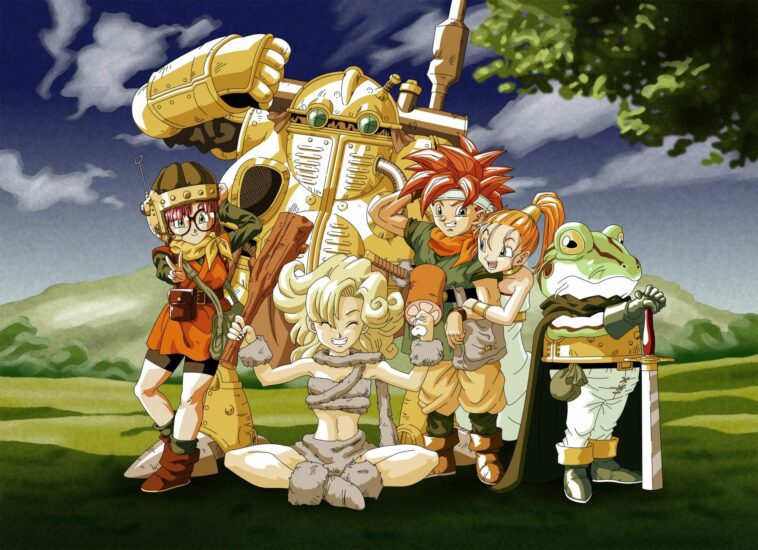Laura Palmer once said, “I’ll see you again in 25 years.” In case you can’t tell by the title of our website, we love Twin Peaks and because of this one line, we make an effort to look back on pieces of significant pop culture when they turn 25. Few other games of 1995 are as significant as the absolutely legendary RPG Chrono Trigger. A classic by any measure, the magnificent RPG turns 25 today. Join me as I look back on what makes this time traveling RPG so timeless.
We Live Inside a Dream (Team)
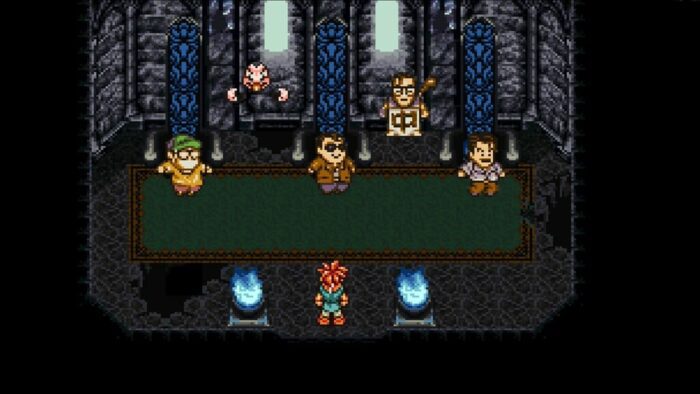
It really helps your game to have creative and passionate people on the development team. And with Chrono Trigger, you couldn’t have asked for any better. You had Hironobu Sakaguchi, the creator of the at-its-peak Final Fantasy franchise; Yuji Horii, creator of the big-in-Japan Dragon Quest franchise; and, rounding out the core trio, you had legendary artist Akira Toriyama to design the characters and enemies. While each of those respective franchises have had peaks and lulls (the previous year saw the release of Final Fantasy VI, which is, for my money, the absolute best game in the franchise and one of the best RPGs ever made), the mid ’90s were a glorious time for 16-bit JRPGs on the SNES.
I would kill to see some kind of documentary on exactly how these gaming giants played off of each other. While both are classic in their own right, Final Fantasy and Dragon Quest both diverged pretty significantly during the SNES era, with the former adopting a more experimental approach and the latter remaining doggedly unchanged. Regardless, this union of creative people, along with the instantly recognizable art style of Mr. Toriyama, paid off in a big way.
You’d Never Guess. There Was a Glitch…In the Time Machine.
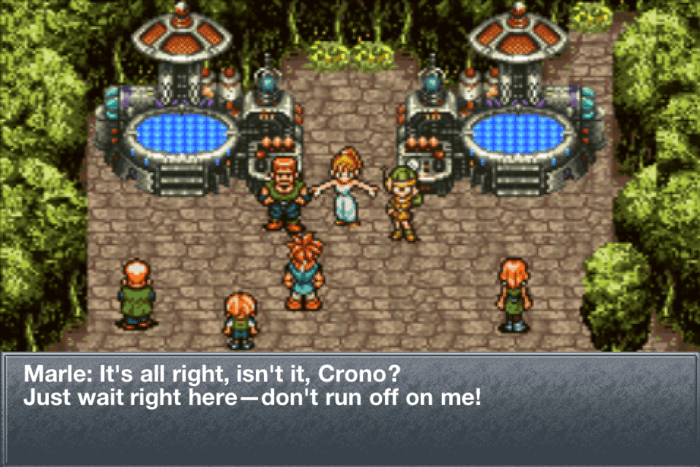
In many ways, from a storytelling standpoint, Chrono Trigger is as traditional JRPG narrative as they come, with a big bad named Lavos threatening to destroy Earth in the year 1999. Like many parts of life, though, the most interesting parts of the story lie in the details. For one thing, the game introduced a time travel mechanic that was more or less unheard of in gaming at the time. Crono awakens the morning of the Millennial Fair (no telling if this fair is actively destroying the wool sweater industry) and goes to see his friend Lucca’s new invention. Lucca has made a prototype teleporter that doubles as a time machine, and before long, Crono is swept away to the year 600 AD to save Marle, the princess of Guardia.
Like all good fantasy stories, the stakes start off fairly low before growing and growing into something grander. It’s an effective way to get the player comfortable with the world, and it works wonders here. Crono discovers more characters who join him on his quest, my favorite of which is the Frog Knight… well, Frog, whose back story is much more emotional than it has any right to be.
And that kind of summarizes what makes the game’s story so great. As you travel through time, you learn more and more about each character and get invested in their own personal journey. The aforementioned Frog was transformed by the dastardly Magus, a magic user who is more than what he seems. The end of his story arc leads to the choice to kill Magus for what he has done, or forgive him and let him join the party. There are plenty of other, smaller choices sprinkled throughout as well, but this is a highlight of the game marrying itself to its story. We’ll get to the biggest choice of all in a short while.
There’s nothing mind-blowing about the story. It is an archetypical Hero’s journey through time to stop a big bad thing from destroying the future. But it works so well because of its attention to its cast. You care about them, and as a result, you care about the times they inhabit. Plus, the game smartly shows Lavos’s effect on the world in each different era, with it falling from space when you travel back to 65,000,000 BC. The most interesting part is in the Antiquity era, where people live in the sky and the matriarch of the world is obsessed with bringing Lavos out of its shell. All these little details and fantastic character work make you invested in the outcome of the tale, even if you can guess how it ends.
What Can You Tell Me About These Battles, Sheriff?
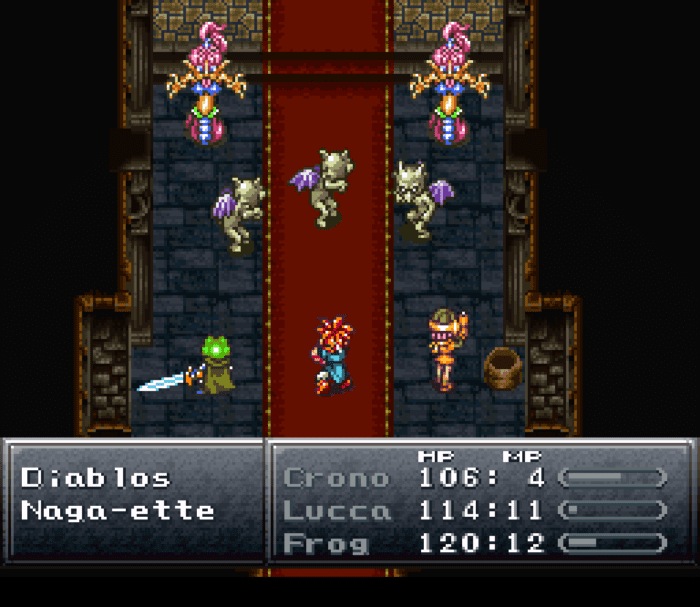
Chrono Trigger is a classic based solely on its story, but its gameplay is no slouch, either. At the time, Final Fantasy had introduced Active Time Battle, a hybrid of turn based battling with real time elements where characters can act after filling up a movement gauge. Chrono Trigger adopted that and took it a step further. No longer do characters stand in rows and whack away at enemies. Instead, positioning is key in Chrono Trigger’s battles. Different moves can often times hit more than one enemy depending on their effect. For instance, Crono gets a move early on that sees him spin with his sword in a circle for a few moments. You could use that move to hit the enemy on the right, but it’s much more effective to hit the enemy in the middle, as his blade will reach both of the enemies flanking the middle one.
Granted, this system was new at the time and has a few dated elements. To my knowledge, there is no way to move characters once you enter battle, and since each battle has different enemy placement, there’s some trial and error in getting your characters in the ideal layout for a given fight. The fact that there are no random encounters means that the developers were able to carefully manage each enemy encounter in the game, lending a sense of craftsmanship to everything despite being locked into a given position once it starts.
The game more than makes up for this with its introduction of dual and triple attacks. Depending on your party composition, you can pull off more powerful moves, and the game is designed in a way such that you should have at least one ultimate attack in the end game regardless of who’s in your party. For instance, you might be able to do Crono’s aforementioned spinning attack, then follow it up with a stab into the enemy, then have Lucca blast them with fire. Unsurprisingly, attacks become more and more elaborate as the game goes on, with some really devastating moves coming late in the game. The fact that there are so many combinations encourages the player to experiment with different party set ups, and that in turn invests you in the different characters.
Like the story, the battles are a combination of elements we’ve seen before, as well as some that we haven’t. Regardless, the battle system remains a blast to use to this day thanks to the powerful combo moves at the player’s disposal.
The Kind of Game That Makes You Wish You Designed a Little Pixel Art
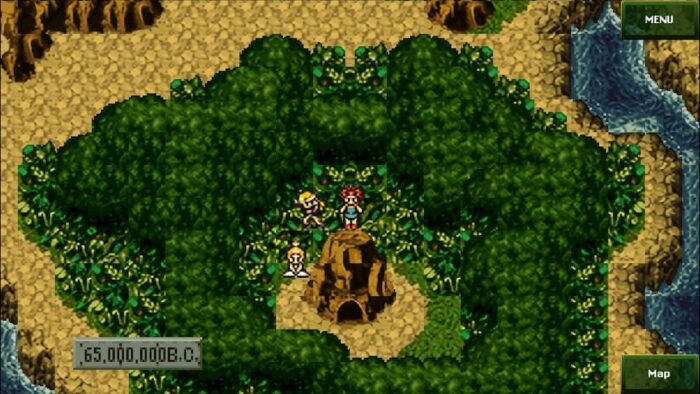
Another reason the game has aged so well is that it is a platinum standard for 16 bit pixel art and music. On the subject of the former, character sprites are given fluid animations a large character models, contrasting with the somewhat chibi designs of Final Fantasy and the basic sprites of Dragon Quest. Environments got the same level of attention, with everything from futuristic ruins to medieval cathedrals giving the game plenty of variety. It’s a testament to just how good looking 16 bit pixel art can be, and looks mostly flawless to this day.
The music is no slouch, either. With a powerful combination of Yasunori Mitsuda and Final Fantasy veteran Nobuo Uematsu, it’s tough to find even one bad track from the game. My personal favorite is, surprisingly, “Memories of Green,” the overworld theme from 1000 AD. It’s simply beautiful, relaxing, nostalgic, hopeful, and melancholy, and remains one of my favorite songs from a video game period. Still, there’s not a bad track in the bunch.
An Idea Both Wonderful and Strange
Even ignoring the fact that it lets you easily re- experience the outstanding story, New Game Plus was a revolution.Perhaps Chrono Trigger’s largest contribution to gaming is New Game Plus. I have no idea if the game created this idea or not, but if you know of one that did this before Chrono Trigger, let me know in the comments. Anyways, New Game Plus allowed players to start the game over from the beginning with all of their equipment and levels intact. It’s a feature that is still seen in games today, main JRPGs and action games like Nier Automata.
It’s an already-great feature for any long game to have, particularly one where you see such huge character growth over the course of the game. And it allows people to experience the story all over again without necessarily having to worry about the challenge. However, Chrono Trigger went an extra step and made it crucial to seeing everything the game has to offer.
Early in the game, Crono and co. are brought to a realm between time periods due to shenanigans. They can travel to the many different time periods by interacting with different buckets. However, they are told that there is one bucket in particular to be wary of. It leads directly to 1999 on the day that Lavos awakens and destroys the world. From there, players can actually challenge the final boss at any time, although you’re likely to get wiped out if you try to do it before the right moment on your first play-through.
The brilliant twist is that, depending on when you fight Lavos, you can get a variety of endings. Some are jokes or Easter Eggs, like the Square Enix staple of the Developer Room, but others are genuinely emotional twists on the game’s standard ending, such as one where Crono is dead. The game doesn’t just introduce a cool new feature; it incentivizes players to actually use it and experiment with it in order to see every possible ending. In other words, this feature that has become a staple of the genre and video games as a whole, is actually an integral game mechanic if you want to see everything the game has to offer. Plenty of other games lift this feature, but few implement it as meaningfully as Chrono Trigger.
It Happened Again
It’s worth noting that the game has seen a few different re-releases. The version I’m most familiar with is the DS one, which saw the addition of two end game scenarios and a brand new ending that supposedly ties into Chrono Cross. I can’t confirm that, as I haven’t played the sequel. But the game is worth of re-releases, with the most recent version being the Steam one. I’ve heard there are technical issues with the game, but can’t say for sure. Regardless, there are a few different ways to experience this wonderful game, and for my money, the DS remake is a fantastic, on the go experience with plenty of extra content to keep you busy.
I’ll See You Again in 1999 AD
It’s tough to believe that 1995 was 25 years ago (yours truly was one year old then). A lot has happened between then and now, both in gaming and the world as a whole. It takes something truly special to stand the test of time Chrono Trigger has, but as we’ve discussed, it’s well deserving of its place in gaming history. While there are some undeniably dated parts of the game, it still delivers an incredibly wonderful and emotional story, backed up by fun and innovative ideas that pushed the envelope of what a JRPG was at the time. Its legacy is still felt to this day. Seriously, go on Steam and explore the huge amount of indie RPGs on there and see how many cite Chrono Trigger as an influence. There’s even a game that was released in 2011 called Radiant Historia that borrows many of the time travel ideas of CT and uses them to pave its own path.
Any way you slice it, Chrono Trigger is an enduring classic, and will likely be remember as such in another 25 years.

